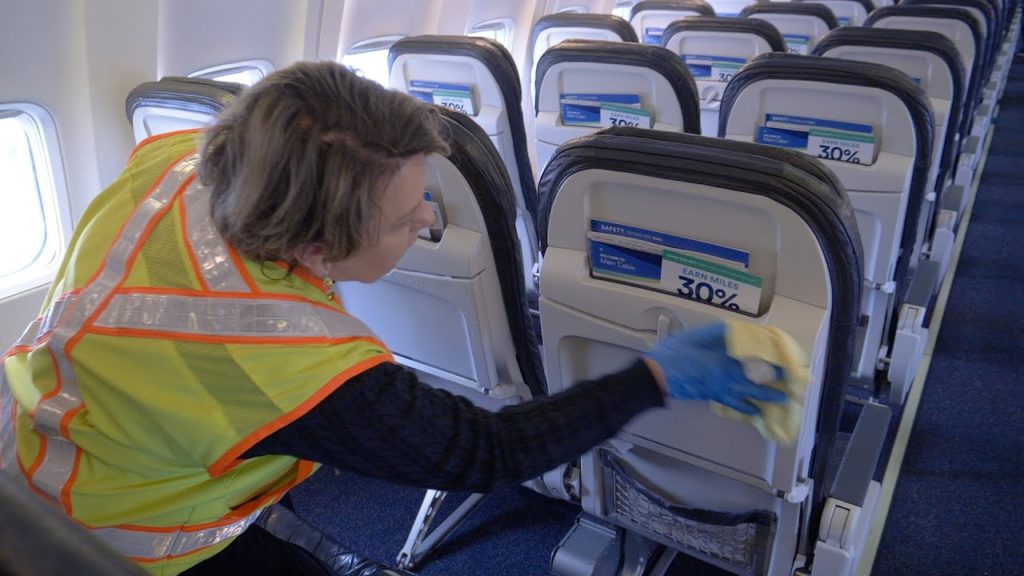Airlines Ramp Up Cabin Cleaning Procedures Amid Coronavirus
Carriers expanding sanitation, disinfectant guidelines to better protect passengers, crew
By Evan Dougherty
Published May 18, 2020
Read Time: 4 mins
For many airlines, ensuring the cleanliness of an airplane has never been more important.
As stay-at-home orders across the country are beginning to lift, airlines and airports are preparing for a potential rise in passenger traffic. For airlines, this includes a new emphasis on cleaning airplane cabins to help prevent the spread of COVID-19.
Normally, airplanes are filled with dozens of passengers on multiple flights between cities each day. With lots of different touchpoints, cabins present a challenging environment for airlines to maintain.
Cleaning more frequently and thoroughly
Most U.S. carriers have designed their cleaning policies based on Centers for Disease Control and Prevention (CDC) guidelines and have also created more aggressive disinfection measures that involve wiping down high-contact surfaces more frequently. Recently, American Airlines announced expanded cleaning procedures to be carried out between every flight. These include using an EPA-approved disinfectant on public surfaces like seatback screens and overhead bins. Flight attendant jumpseats and cockpit surfaces will also be regularly disinfected.
Starting this month, American is also distributing sanitizing wipes and gels to passengers prior to boarding. The Fort Worth, Texas-based carrier plans to expand this policy for all flights in coming weeks depending on the availability of supplies.
“We are looking out for our customers’ well-being to give them peace of mind while they travel with us,” Kurt Stache, Senior Vice President of Customer Experience at American said in a statement in late April. “We’re moving quickly on these enhancements and we’ll continue to improve the travel experience for our customers and team members as we navigate these times together.”
Meanwhile, Southwest is one of several carriers to begin “fogging” the interiors of all aircraft overnight. This process involves the use of electrostatic sprayers dispersing a liquid mist that adheres to surfaces, killing germs on contact. On its website, Southwest assures its customers that all of its planes are cleaned 6-7 hours each night with disinfectant solutions approved by the CDC and WHO.
Nearly all U.S. airlines have increased the amount of times their airplane cabins are sanitized each day – providing flight crews disinfectant wipes to use between every flight. International flights have more rigorous procedures in place, especially for those arriving from areas with widespread outbreaks.

Airlines have increased the frequency of cleaning procedures on board aircraft, in addition to other changes to help prevent the spread of COVID-19. (Image courtesy of Alaska Airlines)
Southwest is also encouraging its customers to bring hand sanitizer and will provide wipes to every passenger on board, upon request. The airline is limiting the number of available seats to give travelers more personal space.
Similarly, United announced this month that it will notify passengers 24 hours in advance if their flight is expected to be crowded. The carrier will offer its customers the option to rebook onto a less-full flight free of charge.
Another new common practice by airlines, including Delta: blocking off middle seats and suspending most meal services. At Delta, all classes on flights over 350 miles will have snack and beverage service, while only First Class will have service for flights less than 350 miles. Alaska is also prohibiting all onboard service for flights under 350 miles to reduce contact between passengers and flight attendants.
Some carriers, including Spirit Airlines, are also removing snack and drink menus from seat back pockets on board in an effort to reduce the number of touchpoints for passengers.
Cabin filtration
As COVID-19 is transmittable through respiratory droplets, travelers may also speculate on the quality of the air inside an airplane cabin.
On commercial planes, passengers breathe in a mixture of fresh and recirculated air. Fresh air comes from a plane’s bleed air system, where it is taken from the hot compressor section of both engines. Pneumatic air cycle kits, known as “packs,” cool the air and release it into the cabin through “gasper nozzles” located above the seats.
Air is then re-circulated throughout the cabin, passing through specialized HEPA filters along the way. According to the CDC, these filters have the ability to capture 99.9 percent of airborne particles, including viruses that may be present. Air inside cabins is usually filtered at a rate of 20-30 times per hour.
Like disinfectant procedures, airlines are increasing the rate of which HEPA filters are swapped out – making sure that the cabin air stays as clean as possible. Delta Air Lines, for example, has established new procedures to replace filters more often.
“We’ve introduced maintenance programs to ensure that we provide the highest quality of cabin air on our airplanes,” Gary Martin, Managing Director of Engineering for Delta, said in a video. “In fact, in many cases, [it’s] more frequently than the manufacturers recommend.”
Along with enhancing cleaning procedures and taking other measures to ensure the safety of travelers and crew, airlines are adding new requirements for travelers.
Policies for a number of carriers include mandatory use of face masks for passengers in addition to crew. Starting this month, most airlines will require passengers to bring masks on board and strongly encourage their use during a whole trip.
Other airlines are also expected to begin temperature checks on passengers. This month, Air Canada began touchless temperature checks on all travelers prior to boarding. Like Air Canada, Frontier will also conduct temperature checks on its passengers.
Read here for more on best practices for keeping healthy while traveling.
Watch
This Next
Read
This Next





